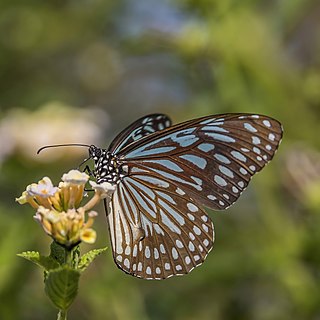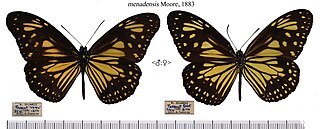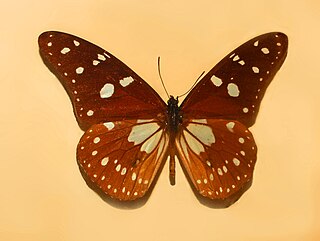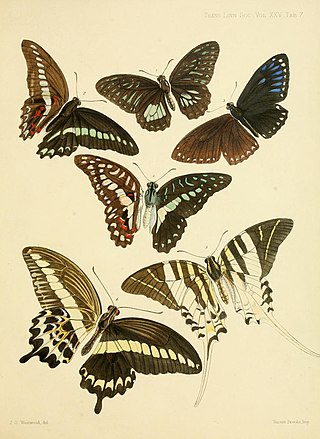
The white wagtail is a small passerine bird in the family Motacillidae, which also includes pipits and longclaws. The species breeds in the Palearctic zone in most of Europe and Asia and parts of North Africa; it also has a toehold in western Alaska as a scarce breeder. It is resident in the mildest parts of its range, but otherwise migrates to Africa. In total, there are between 9 and 11 subspecies of M. alba; in Ireland and Great Britain, the black-backed subspecies known as the pied wagtail predominates.

Nymphaea alba, the white waterlily, European white water lily or white nenuphar, is an aquatic flowering plant in the family Nymphaeaceae. It is native to North Africa, temperate Asia, Europe and tropical Asia.

The white tern or common white tern is a small seabird found across the tropical oceans of the world. It is sometimes known as the fairy tern, although this name is potentially confusing as it is also the common name of Sternula nereis. Other names for the species include angel tern and white noddy in English, and manu-o-Kū in Hawaiian. The little white tern, previously considered a subspecies of the white tern, is now recognised as a separate species.

Tirumala limniace, the blue tiger, is a species of butterfly found in South Asia, and Southeast Asia that belongs to the brush-footed butterfly family, Nymphalidae. More specifically it is part of the crows and tigers or danaid group. This butterfly shows gregarious migratory behaviour in southern India. In some places, it may be found in congregations with Danaus genutia, Tirumala septentrionis, Euploea sylvester, Euploea core, Parantica aglea, and at high elevations, with Parantica nilgiriensis, on Crotalaria.

Tirumala septentrionis, the dark blue tiger, is a danaid butterfly found in the Indian subcontinent and Southeast Asia.

Tirumala gautama, the scarce blue tiger, is a butterfly species found in India and Southeast Asia that belongs to the "crows and tigers", that is, the danaid group of the brush-footed butterflies family.

Tirumala is a genus of brush-footed butterflies erected by Frederic Moore in 1880. Its species are distributed in Africa, Asia, and Australia.

The Comoro friar is a species of nymphalid butterfly in the Danainae subfamily. It is endemic to the Comoros, where it is only found on the island of Grand Comore.

The Seram crow is a species of nymphalid butterfly in the Danainae subfamily. It is endemic to Indonesia.

The Seram small tree-nymph is a species of nymphalid butterfly in the Danainae family. It is endemic to Seram, Indonesia.
Kuekenthal's yellow tiger is a species of nymphalid butterfly in the Danainae subfamily. It is endemic to Indonesia.

The Manado yellow tiger is a species of nymphalid butterfly in the Danainae subfamily. It is endemic to Sulawesi, Indonesia.
The crow tiger is a species of nymphalid butterfly in the Danainae subfamily. It is endemic to the Solomon Islands.
Speleoperipatus is a monospecific genus of velvet worm in the Peripatidae family, containing the single species Speleoperipatus spelaeus. This species is a pale greenish yellow, almost white, with 22 or 23 pairs of legs and no eyes. Specimens range from 27 mm to 34 mm in length. The minimum number of leg pairs found in this species (22) is also the minimum number found in the neotropical Peripatidae. This velvet worm is viviparous, with mothers supplying nourishment to their embryos through a placenta.

Many populations of Lepidoptera migrate, sometimes long distances, to and from areas which are only suitable for part of the year. Lepidopterans migrate on all continents except Antarctica, including from or within subtropical and tropical areas. By migrating, these species can avoid unfavorable circumstances, including weather, food shortage, or over-population. In some lepidopteran species, all individuals migrate; in others, only some migrate.

Tirumala petiverana, the blue monarch, African blue tiger, or dappled monarch, is a butterfly of the family Nymphalidae. It is widespread in tropical and subtropical Sub-Saharan Africa. Their habitat consists of Afromontane, lowland and riverine forests as well as moist savanna.

Tirumala formosa, the forest monarch or beautiful tiger, is a butterfly of the family Nymphalidae.

Graphium thule is a species of butterfly in the family Papilionidae. It is found in New Guinea. The larva feeds on Aquifoliacene ilex.

Peripatopsis alba, the white cave velvet worm, is a species of velvet worm in the family Peripatopsidae. This species is notable as one of only two species of velvet worm known to be troglobitic; the only other velvet worm known to be a troglobiont is Speleoperipatus spelaeus. The white cave velvet worm is rare and limited to one cave system on Table Mountain in South Africa.

Tirumala tumanana is a butterfly species within the Danainae subfamily of the family Nymphalidae. The butterfly is found in the extreme southern regions of the Philippines, including Sarangani and Balut Islands, as well as parts of Mindanao. It was first described by Georg Semper in 1886 based on specimens collected from Tumanao on Sarangani Island, located in the southern Philippines. Although Tirumala tumanana was originally considered a subspecies of Tirumala choaspes or Tirumala limniace due to its morphological similarities, recent studies focusing on male genitalia, wing patterns, and androconial organs have established it as a distinct and geographically isolated species.

















